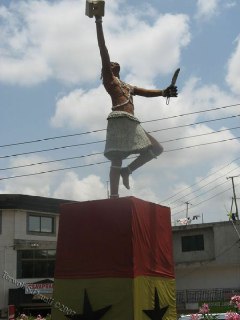The Asante Empire, was an Akan kingdom from 1701 to 1957, in what is now modern-day Ghana, expanded from Ashanti to include the Brong-Ahafo Region, Central Region, Eastern Region, Greater Accra Region and Western Region of present-day Ghana.
Due to the empire’s extraordinary military ability, wealth, architecture, sophisticated hierarchy and culture, the Ashanti Kingdom survives as a constitutionally protected, sub-national traditional state in union with the Republic of Ghana.
The Ashanti Kingdom is the home to Lake Bosumtwi, Ghana’s only natural lake. The state’s current economic revenue is derived mainly from trading in gold bars, cocoa, kola nuts and agriculture.
In the late 17th century, the Ashanti King Osei Tutu , who reigned from 1695 – 1717 and his adviser Okomfo Anokye established the Ashanti Kingdom, with the Golden Stool of Asante as a sole symbol of unity.
Osei Tutu oversaw a massive Ashanti territorial expansion, building up the army by introducing new organisation and turning a disciplined royal and paramilitary army into an effective fighting machine. In 1701, the Ashanti army conquered Denkyira, giving the Ashanti access to the Gulf of Guinea and the Atlantic Ocean coastal trade with Europeans, notably the Dutch.
The Ashanti Empire fought several wars with neighboring kingdoms and lesser organized tribes such as the Fante. The Ashanti defeated the British Empire’s invasions in the first two of the four Anglo-Ashanti Wars, killing and keeping British army general Sir Charles MacCarthy’s skull as a gold-rimmed drinking cup in 1824.
Due to British improvements in weapons technology, burning and looting of the capital Kumasi and final defeat at the fifth Anglo-Ashanti War, the Ashanti empire became part of the Gold Coast colony in January 1, 1902.
The advisor of the King, Okomfo Anokye aided the empire’s victories with ‘spiritual ‘ help. Okomfo Anokye (also known as Kwame Agyei, Kotowbere, or Tsala) was a traditional priest in the Asante Empire. Known for his participation in the expansion of the Ashanti Empire, there are differing accounts regarding Okomfo Anokye’s origins.
According to the Akuapem tradition, for instance, he was son of Ano and Manubea, both from Awukugua in the Nifa Division of the Okere state.
This claim was apparently later confirmed by Otumfuo Nana Osei Tutu II during his visit at Awukugua in 2014.
According to Asante traditions, he was the grandson of a man called Amoa Gyata from Bona-Bom, Adanse.
There are also claims that he was the son of Kyei Birie and Dwirawira Kwa, who was an Asenie woman from Adanse-Akrokyere.
According to Anlo-Ewe traditions, Okomfo Anokye was from Notsie. His original name was Tsala, and he was the twin brother of Tsali. His name would thus originate from an Asante corruption of “Notsie” i.e “Okomfo of Notsie”. The Ewe mythology that Okomfo Anokye was from Notsie and Asantes called him Okomfo Anokye signifying “Okomfo a ofiri Notsie” (i.e.: Okomfo who comes from Notsie) cannot be reconciled with Asante or indeed Akan naming conventions.
Over 300 years ago, in 1695, this traditional priest planted a sword( which cannot be removed) at the exact place where the Golden Stool of Asanteman descended unto the laps of King Osei Tutu I, “Opemsuo” the founder of Asante Nation, which is believed to hold the Ashanti kingdom from collapsing.
The ‘immovable’ Sword driven into the ground by Okomfo Anokye remains. History has it that, Okomfo pronounced that no one would be able to remove the sword, and so it has remained in spite of futile attempts to uproot.
The site was predicted by Okomfo Anokye to be a healing place for millions of people.
Now, the site happens to be the exact place where the Komfo Anokye Teaching Hospital is situated.
Today, the place has been turned into a historic site for tourists and all to learn about the beautiful art and history of the Ashanti Kingdom and their ‘hero’s, the late Okomfo Anokye.
On a good day of visiting the site, one may run into the Asante King who regularly comes to pay his respects at this important and sacred site.
A tour of the site offers one great insight about the beginning of the Ashanti Kingdom. The landmark has been protected for future generations.
At the site, a replica of the sword and symbol of unity and strength of the Ashanti people is situated.
REFERENCES
1. Available online at, https://visitghana.com/attractions/okomfo-anokye-sword-site/.


